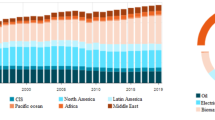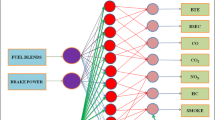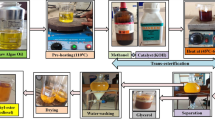Abstract
This work aims to define the influence of different parameters (such as ethanol concentration, type (regular or homologation fuel), and formulation (olefin and aromatic contents) of gasoline, temperature, and aging duration) in gum formation in Brazilian ethanol–gasoline blends. As a result, a database with more than 500 cases was built gathering experimental measures of unwashed and washed gum contents from the literature and original experimental data. Two approaches considered to define the mathematical models capable of predicting gum formation are compared: a linear equation with rectangular interaction terms and artificial neural network (ANN) models. Different ANN topologies were investigated and the most robust models were compared to polynomial equations. Then, response surfaces were plotted to verify the consistency of the model in the entire experimental domain. The ANN models performed better. Indeed, the coefficient of determination reached values as high as 0.953 and 0.984, for the testing data of washed and unwashed gum content, respectively, and lower differences with experimental data were observed, up to 0.5 and 0.2%, respectively. Additionally, the ANN models were more robust than the specific quadratic model available in the literature. In terms of the impact of the ethanol, it is possible to confirm a catalytic effect after aging at medium or high temperatures for washed gum formation at low concentrations of ethanol in gasoline. Without aging or after storage at low temperatures, ethanol has a simple dilution effect. Such conclusions are in agreement with previous literature and explain why some authors observed either catalytic or dilution effects of ethanol.






Similar content being viewed by others
Explore related subjects
Discover the latest articles, news and stories from top researchers in related subjects.Data availability
The datasets generated during and/or analyzed during the current study are available from the corresponding author upon reasonable request.
References
Fan YV, Perry S, Klemeš JJ, Lee CT (2018) A review on air emissions assessment: transportation. J Clean Prod 194:673–684. https://doi.org/10.1016/j.jclepro.2018.05.151
Szybist JP, Busch S, McCormick RL, Pihl JA, Splitter DA, Ratcliff MA, Kolodziej CP, Storey JME, Moses-DeBusk M, Vuilleumier D, Sjöberg M, Sluder CS, Rockstroh T, Miles P (2021) What fuel properties enable higher thermal efficiency in spark-ignited engines? Prog Energy Combus Sci 82:100876. https://doi.org/10.1016/j.pecs.2020.100876
International Renewable Energy Agency (2022) World energy transitions outlook 2022: 1.5 °C Pathway
International Energy Agency (2022) Renewables 2022 Analysis and forecast to 2027, 159
International Renewable Energy Agency (2021) Renewable power generation costs in 2021
Mobin Siddique MB, Khairuddin N, Ali NA, Hassan MA, Ahmed J, Kasem S, Tabassum M, Afrouzi HN (2021) A comprehensive review on the application of bioethanol/biodiesel in direct injection engines and consequential environmental impact. Clean Eng Technol 3:100092. https://doi.org/10.1016/j.clet.2021.100092
Santos NDSA, Roso VR, Malaquias ACT, Baêta JGC (2021) Internal combustion engines and biofuels: Examining why this robust combination should not be ignored for future sustainable transportation. Renew Sustain Energy Rev 148:111292. https://doi.org/10.1016/j.rser.2021.111292
Gray R (2020) Why raising the alcohol content of Europe’s fuels could reduce carbon emissions. https://ec.europa.eu/research-and-innovation/en/horizon-magazine/why-raising-alcohol-content-europes-fuels-could-reduce-carbon-emissions (Accessed Jan 20, 2023)
U.S. Energy Information Administration, Biofuels explained–Ethanol (2022) https://www.eia.gov/energyexplained/biofuels/ethanol-use.php (Accessed Jan 20, 2023)
Ministério da Agricultura, Pecuária e Abastecimento do Brasil, Página 17 da Seção 1 do Diário Oficial da União (DOU) de 6 de Março de 2015 (2015) https://www.jusbrasil.com.br/diarios/87237712/dou-secao-1-06-03-2015-pg-17 (Accessed Jan 20, 2023)
Bamidele T, Onuigbo-Nweze C, Osuagwu M, Azubuike A, Joel O, Onyewuchi A (2018) Evaluating and inhibiting gum formation tendencies in gas condensates. In: All Days, SPE, Lagos, Nigeria. p SPE-193458-MS. https://doi.org/10.2118/193458-MS
Batts BD, Fathoni AZ (1991) A literature review on fuel stability studies with particular emphasis on diesel oil. Energy Fuels 5:2–21. https://doi.org/10.1021/ef00025a001
Pradelle F, Braga SL, Martins ARFA, Turkovics F, Pradelle RNC (2015) Gum formation in gasoline and Its blends: a review. Energy Fuels 29:7753–7770. https://doi.org/10.1021/acs.energyfuels.5b01894
Pradelle F, Leal Braga S, de Fonseca Aguiar Martins AR, Turkovics F, Nohra Chaar Pradelle R (2017) Certainties and challenges in modeling unwashed and washed gums formation in Brazilian gasoline–ethanol blends. Chem Eng Res Des 122:77–96. https://doi.org/10.1016/j.cherd.2017.03.037
Liu W, Safdari Shadloo M, Tlili I, Maleki A, Bach Q-V (2020) The effect of alcohol–gasoline fuel blends on the engines’ performances and emissions. Fuel 276:117977. https://doi.org/10.1016/j.fuel.2020.117977
Pereira CC, Pasa VMD (2005) Effect of alcohol and copper content on the stability of automotive gasoline. Energy Fuels 19:426–432. https://doi.org/10.1021/ef049849h
Streva ER, Pasa VMD, Sodré JR (2011) Aging effects on gasoline–ethanol blend properties and composition. Fuel 90:215–219. https://doi.org/10.1016/j.fuel.2010.07.056
Teixeira LSG, Souza JC, dos Santos HC, Pontes LAM, Guimarães PRB, Sobrinho EV, Vianna RF (2007) The influence of Cu, Fe, Ni, Pb and Zn on gum formation in the Brazilian automotive gasoline. Fuel Process Technol 88:73–76. https://doi.org/10.1016/j.fuproc.2006.08.008
D’Ornellas CV (2001) The effect of ethanol on gasoline oxidation stability. SAE Trans. https://doi.org/10.4271/2001-01-3582
Pradelle FAY, Braga SL, Martins ARFA, Turkovics FY, De Souza RNC (2015) Experimental study of the influence of ethanol concentration and temperature on gum formation during prolonged storage of Brazilian gasoline-ethanol blends, pp 2015-36-0169. https://doi.org/10.4271/2015-36-0169
Pradelle F, Leal Braga S, de Fonseca Aguiar MartinsTurkovics ARF, Nohra Chaar Pradelle R (2016) Modeling of unwashed and washed gum content in Brazilian gasoline-ethanol blends during prolonged storage: application of a doehlert matrix. Energy Fuels 30:6381–6394. https://doi.org/10.1021/acs.energyfuels.6b01379
Jęczmionek Ł, Danek B, Pałuchowska M, Krasodomski W (2017) Changes in the quality of E15–E25 gasoline during short-term storage up to four months. Energy Fuels 31:504–513. https://doi.org/10.1021/acs.energyfuels.6b01260
Pereira AAC, Olivera CAC, Merma AG, Hacha RR, Ferreira dos Santos B, Torem ML (2021) Mineral bioflotation optimization: comparison between artificial neural networks and response surface methodology. Min Eng 169:106983. https://doi.org/10.1016/j.mineng.2021.106983
Dey S, Reang NM, Das PK, Deb M (2021) Comparative study using RSM and ANN modelling for performance-emission prediction of CI engine fuelled with bio-diesohol blends: a fuzzy optimization approach. Fuel 292:120356. https://doi.org/10.1016/j.fuel.2021.120356
Rezaei J, Shahbakhti M, Bahri B, Aziz AA (2015) Performance prediction of HCCI engines with oxygenated fuels using artificial neural networks. Appl Energy 138:460–473. https://doi.org/10.1016/j.apenergy.2014.10.088
Uslu S, Celik MB (2020) Performance and exhaust emission prediction of a SI engine fueled with I-amyl alcohol-gasoline blends: an ANN coupled RSM based optimization. Fuel 265:116922. https://doi.org/10.1016/j.fuel.2019.116922
Aydın M, Uslu S, Bahattin Çelik M (2020) Performance and emission prediction of a compression ignition engine fueled with biodiesel-diesel blends: a combined application of ANN and RSM based optimization. Fuel 269:117472. https://doi.org/10.1016/j.fuel.2020.117472
Tuan Hoang A, Nižetić S, Chyuan Ong H, Tarelko W, Viet Pham V, Le Hieu T, Quang Chau M, Phuong Nguyen X (2021) A review on application of artificial neural network (ANN) for performance and emission characteristics of diesel engine fueled with biodiesel-based fuels. Sustain Energy Technol Assess 47:101416. https://doi.org/10.1016/j.seta.2021.101416
Seo J, Yun B, Park J, Park J, Shin M, Park S (2021) Prediction of instantaneous real-world emissions from diesel light-duty vehicles based on an integrated artificial neural network and vehicle dynamics model. Sci Total Environ 786:147359. https://doi.org/10.1016/j.scitotenv.2021.147359
Akolaş Hİ, Kaleli A, Bakirci K (2021) Design and implementation of an autonomous EGR cooling system using deep neural network prediction to reduce NOx emission and fuel consumption of diesel engine. Neural Comput Appl 33:1655–1670. https://doi.org/10.1007/s00521-020-05104-1
Ghazikhani M, Mirzaii I (2011) Soot emission prediction of a waste-gated turbo-charged DI diesel engine using artificial neural network. Neural Comput Appl 20:303–308. https://doi.org/10.1007/s00521-010-0500-7
Chaki S, Biswas TK (2023) An ANN-entropy-FA model for prediction and optimization of biodiesel-based engine performance. Appl Soft Comput 133:109929. https://doi.org/10.1016/j.asoc.2022.109929
Bhowmik S, Paul A, Panua R, Ghosh SK, Debroy D (2018) Performance-exhaust emission prediction of diesosenol fueled diesel engine: an ANN coupled MORSM based optimization. Energy 153:212–222. https://doi.org/10.1016/j.energy.2018.04.053
Ahmed Qasem MA, Al-Mutairi EM, Abdul Jameel AG (2023) Smoke point prediction of oxygenated fuels using neural networks. Fuel 332:126026. https://doi.org/10.1016/j.fuel.2022.126026
Jahirul MI, Rasul MG, Brown RJ, Senadeera W, Hosen MA, Haque R, Saha SC, Mahlia TMI (2021) Investigation of correlation between chemical composition and properties of biodiesel using principal component analysis (PCA) and artificial neural network (ANN). Renew Energy 168:632–646. https://doi.org/10.1016/j.renene.2020.12.078
Ude CN, Onukwuli DO, Okey-Onyesolu FC, Nnaji PC, Okoye CC, Uwaleke CC (2022) Prediction of some thermo-physical properties of biodiesel using ANFIS and ANN cum sensitivity analysis. Clea Waste Syst 2:100006. https://doi.org/10.1016/j.clwas.2022.100006
Cengiz E, Babagiray M, Emre Aysal F, Aksoy F (2022) Kinematic viscosity estimation of fuel oil with comparison of machine learning methods. Fuel 316:123422. https://doi.org/10.1016/j.fuel.2022.123422
Xia H, Tang J, Aljerf L (2022) Dioxin emission prediction based on improved deep forest regression infor municipal solid waste incineration process. Chemosphere 294:133716. https://doi.org/10.1016/j.chemosphere.2022.133716
Galushka M, Swain C, Browne F, Mulvenna MD, Bond R, Gray D (2021) Prediction of chemical compounds properties using a deep learning model. Neural Comput Appl 33:13345–13366. https://doi.org/10.1007/s00521-021-05961-4
Tang J, Xia H, Aljerf L, Wang D, Ukaogo PO (2022) Prediction of dioxin emission from municipal solid waste incineration based on expansion, interpolation, and selection for small samples. J Environ Chem Eng 10:108314. https://doi.org/10.1016/j.jece.2022.108314
Carvalho JE, Pradelle FAY, Braga S, Martins AR, Turkovics F, Nohra Chaar Pradelle R (2019) Towards a unified understanding of ethanol impact on gum formation in gasoline-ethanol blends: comparison of experimental results with literature. In: Proceedings of the 25th international congress of mechanical engineering, ABCM, https://doi.org/10.26678/ABCM.COBEM2019.COB2019-0207
Aggarwal KK, Singh Y, Chandra P, Puri M (2005) Bayesian regularization in a neural network model to estimate lines of code using function points. J Comput Sci 1:505–509. https://doi.org/10.3844/jcssp.2005.505.509
Acknowledgements
This work was financially supported by Peugeot Citroën do Brasil Automóveis Ltda (currently Stellantis). This study was financed in part by the Coordenação de Aperfeiçoamento de Pessoal de Nível Superior—Brasil (CAPES)—Finance Code 001. The authors would like to thank the CNPq/MCTIC for the financial support to the Department of Mechanical Engineering (DEM) at the Pontifical Catholic University of Rio de Janeiro (PUC-Rio) and the FAPERJ for the Jovem Cientísta do Nosso Estado (JCNE) grant awarded to Florian Pradelle.
Author information
Authors and Affiliations
Corresponding author
Ethics declarations
Conflict of interest
The authors declare no competing financial interest.
Additional information
Publisher's Note
Springer Nature remains neutral with regard to jurisdictional claims in published maps and institutional affiliations.
Supplementary Information
Below is the link to the electronic supplementary material.
Rights and permissions
Springer Nature or its licensor (e.g. a society or other partner) holds exclusive rights to this article under a publishing agreement with the author(s) or other rightsholder(s); author self-archiving of the accepted manuscript version of this article is solely governed by the terms of such publishing agreement and applicable law.
About this article
Cite this article
S. P. Carvalho, J.E., F. Santos, B., F. A. Martins, A. et al. Polynomial and ANN models applied to the formation of gums in Brazilian ethanol–gasoline blends—impact of gasoline composition, ethanol concentration, storage temperature, and aging duration. Neural Comput & Applic 35, 16267–16284 (2023). https://doi.org/10.1007/s00521-023-08396-1
Received:
Accepted:
Published:
Issue Date:
DOI: https://doi.org/10.1007/s00521-023-08396-1




